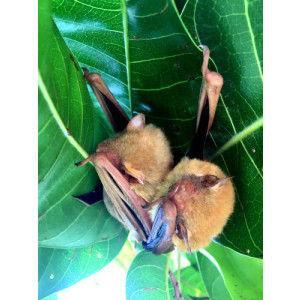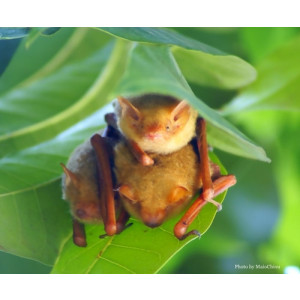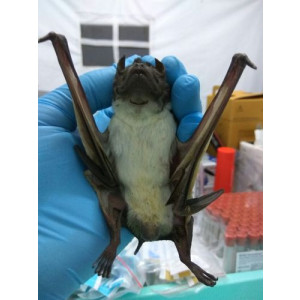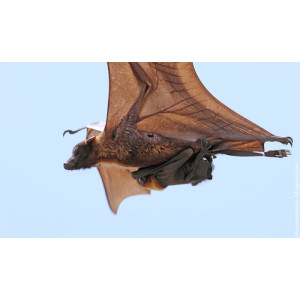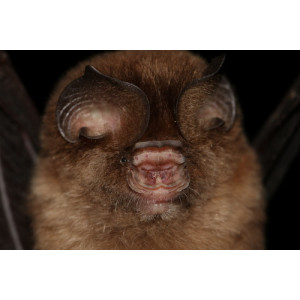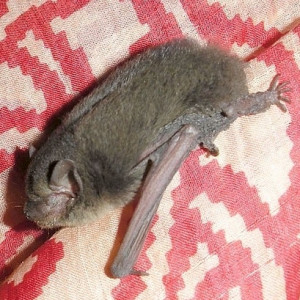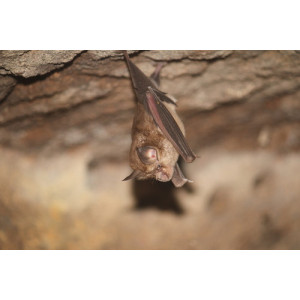@iNaturalist.org
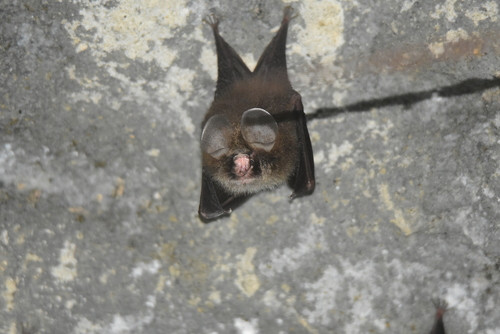
Tail-less Leaf-nosed Bat Did you see this animal?
Scientific Name : Coelops frithii
Family : Hipposideridae
Order : Chiroptera
Class : Mammalia
Phylum : Chordata
Habitat : Forest, Caves and Subterranean Habitats (non-aquatic)
Description : The tail-less leaf-nosed bat is its unique nose structure. Its nose has a leaf-like structure, which helps the bat to emit and detect echolocation calls that bounce off objects in its environment. The nose structure also aids in detecting and locating prey, which mainly consists of insects.
The tail-less leaf-nosed bat is relatively small, with an average length of around 6 cm and a wingspan of 25 cm. Its fur is usually a dark brown or black color, and it has large, round ears. Unlike many other bat species, it has no tail, which is how it gets its common name.
These bats are mostly found in forested areas, but they have also been known to roost in caves and abandoned buildings. They are solitary creatures and are most active at night. During the day, they roost in tree hollows or under the leaves of large plants.
The tail-less leaf-nosed bat primarily feeds on insects, particularly moths and mosquitoes. It uses echolocation to locate its prey, and its specialized nose structure helps it to detect small insects in flight.
The tail-less leaf-nosed bat, but it is believed to breed year-round. Females give birth to a single offspring, which they nurse for several weeks until it is able to fly and forage for itself.
The tail-less leaf-nosed bat uses a combination of echolocation calls and social calls to communicate with other bats. These calls can vary in frequency and duration depending on the situation.
The tail-less leaf-nosed bat has several natural predators, including owls, snakes, and domestic cats. In addition, humans pose a threat through habitat destruction and disturbance.
The tail-less leaf-nosed bat is an important member of its ecosystem as it helps to control insect populations, particularly mosquitoes. However, it is currently considered endangered due to habitat loss and fragmentation caused by deforestation, agriculture, and development. Conservation efforts are underway to protect this species and its habitat.
The tail-less leaf-nosed bat is relatively small, with an average length of around 6 cm and a wingspan of 25 cm. Its fur is usually a dark brown or black color, and it has large, round ears. Unlike many other bat species, it has no tail, which is how it gets its common name.
These bats are mostly found in forested areas, but they have also been known to roost in caves and abandoned buildings. They are solitary creatures and are most active at night. During the day, they roost in tree hollows or under the leaves of large plants.
The tail-less leaf-nosed bat primarily feeds on insects, particularly moths and mosquitoes. It uses echolocation to locate its prey, and its specialized nose structure helps it to detect small insects in flight.
The tail-less leaf-nosed bat, but it is believed to breed year-round. Females give birth to a single offspring, which they nurse for several weeks until it is able to fly and forage for itself.
The tail-less leaf-nosed bat uses a combination of echolocation calls and social calls to communicate with other bats. These calls can vary in frequency and duration depending on the situation.
The tail-less leaf-nosed bat has several natural predators, including owls, snakes, and domestic cats. In addition, humans pose a threat through habitat destruction and disturbance.
The tail-less leaf-nosed bat is an important member of its ecosystem as it helps to control insect populations, particularly mosquitoes. However, it is currently considered endangered due to habitat loss and fragmentation caused by deforestation, agriculture, and development. Conservation efforts are underway to protect this species and its habitat.
Distribution in Bangladesh
References:
description written by:Asad U. Tanvir,Department of Zoology,Jagannath University,Dhaka; reviewed by:Muntasir Akash,Department of Zoology,University of Dhaka;Taxonomic Checklist:Red List of Bangladesh Volume 2: Mammals, 2015, IUCN; information sources:wikipedia,iucnredlist.org; photo credit:George Edward Dobson(www.inaturalist.org/people/George Edward Dobson), photo copyright: iNaturalist.more information please contact with us.
description written by:Asad U. Tanvir,Department of Zoology,Jagannath University,Dhaka; reviewed by:Muntasir Akash,Department of Zoology,University of Dhaka;Taxonomic Checklist:Red List of Bangladesh Volume 2: Mammals, 2015, IUCN; information sources:wikipedia,iucnredlist.org; photo credit:George Edward Dobson(www.inaturalist.org/people/George Edward Dobson), photo copyright: iNaturalist.more information please contact with us.
